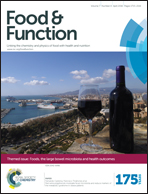A phytochemical and computational study on flavonoids isolated from Trifolium resupinatum L. and their novel hepatoprotective activity
Abstract
Plants from the genus Trifolium have been utilized in the treatment of chronic diseases by many cultures. The aim of this study was to investigate the antioxidant activity of flavonoids isolated from Trifolium resupinatum L. using an in vitro radical scavenging assay and a computational study of the structure–antioxidant activity relationship (SAR). A phytochemical fractionation of the ethanolic extract of T. resupinatum resulted in the isolation of one new flavonoid along with six known flavonoids. The structure of the isolated compounds was elucidated by data obtained from UV, IR, MS, 1D NMR and 2D NMR spectra. The order of antioxidant efficacies of the isolated flavonoids, obtained by DPPH assay, was correlated to that predicted by the computational analysis. To verify the antioxidant potential, the effect of T. resupinatum on oxidative stress, and the expression of the antioxidant enzymes and the redox sensitive nuclear factor erythroid 2-related factor 2 (Nrf2), in a cyclophosphamide-induced hepatotoxicity rat model was investigated. T. resupinatum protected against cyclophosphamide-induced liver injury through attenuation of oxidative stress and inflammation, and up-regulation of Nrf2. Therefore, the present study provides the first clarification of the detailed antioxidant SARs of T. resupinatum flavonoids and points to the involvement of Nrf2 in their hepatoprotective activity.


 Please wait while we load your content...
Please wait while we load your content...